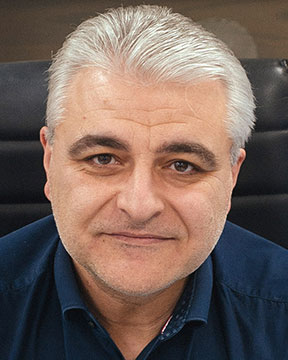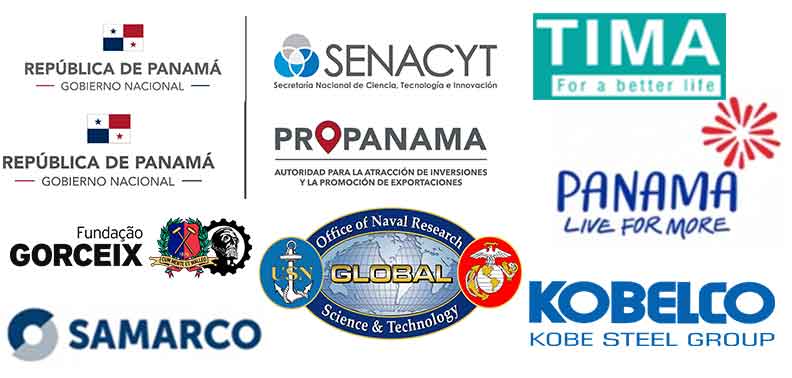























| SESSION: IronTuePM1-R2 | Assis International Symposium (9th Intl. Symp. on Advanced Sustainable Iron & Steel Making) |
| Tue. 28 Nov. 2023 / Room: Dreams 2 | |
| Session Chairs: Tateo Usui; Giulio Antunes De Medeiros; Session Monitor: TBA | |
Industries have been directing their efforts towards improving their production processes, looking for new levels of environmental excellence. After the Paris Agreement set a framework for worldwide developments aimed at mitigating emissions and achieving a positive balance between anthropogenic emission sources, decarbonization has become a global objective. In this context, the use of by-products from other production processes has become essential for industries aiming to implement circular economy principles and contribute to the achievement of ESG goals.In the search for sustainable and innovative ways to generate value for the production of iron ore pellets and for the society hosting its industrial complex, Samarco has identified opportunities to study raw materials obtained from residue generated in the mining of ornamental stones. Samarco’s pelletizing plants are located in a region with the highest production of iron ore pellets in the West and the fifth largest production of ornamental stones in the world. Because of that, its location is ideal for the implementation of circular economy practices by developing sustainable pelletizing raw materials from the high volume of waste generated in the extraction of granite and marble.Samarco is the global pioneer in the use of marble mining residue as an input for pellet production due to the chemical and grindability similarity between marble and the calcitic limestone in the region. After laboratory and industrial-scale tests with excellent physical, chemical, and metallurgical results, results showed that the marble waste from the region has high CaO content, reducing the specific consumption by 16% in comparison to calcitic limestone, to meet the required physicochemical conditions for iron ore fired pellets. This results in a CO2eq- reduction of 6.84 kg per ton of pellets, contributing to decarbonization in pelletizing, in addition to increasing the iron content of the fired pellets by 0.5%. Approximately 800 tons of marble mining waste removed daily from the environment are used as a fluxing agent and basicity corrector in iron ore pellets destined for blast furnaces and direct reduction reactors around the world.Another sustainable raw material for use in iron ore pellets intended for direct reduction reactors is obtained from the cutting of granite stones. This input works as a coating agent, acting as a physical barrier capable of mitigating the tendency of pellets to stick together during reduction at high temperatures (between 950 and 1050 °C). The residue from granite cutting has ideal chemical characteristics and particle size to serve as a coating on pellets, remaining adhered to the surface of the agglomerates even during handling and until their use in the steel industry.In addition to raw materials produced from residue in the mining of ornamental stones, Samarco has been innovatively seeking to diversify the energy matrix of its industrial complex through the increased use of renewable energies, specifically carbonized biomass, as an alternative to fossil fuels such as coal and coke.The carbonization, handling, and fragmentation of charcoal for the supply of independent and integrated pig iron and ferroalloy production plants generate fine carbonaceous residues (charcoal fines), which do not achieve the granulometric specifications for reuse in other metallurgical processes. This material is discarded into the environment without prior treatment, which can have environmental, economic, and social impacts. In this context, studies have shown an opportunity for the recovery and reuse of these fines due to their considerable energy potential.The use of these materials in processes such as pelletizing is considered carbon-neutral since the capture of CO2 occurs during the growth and development of the trees planted to produce the charcoal through the process of photosynthesis. This amount of CO2 is sufficient to compensate what is released during the production (carbonization) and combustion of the charcoal. Substituting the solid fuel matrix for the pelletizing plant in 50% of charcoal can reduce up to 22 kgCO2eq- per ton of pellets. This represents nearly 190.000 tons per year of CO2 removed from the atmosphere.The higher friability of charcoal is advantageous for processes like pelletizing. Being a friable material facilitates grinding the fuel, making it easier to achieve the required particle size for sintering and pelletizing. Samarco conducted laboratory tests incorporating charcoal fines into pellet production to increase the diversification of its energy matrix with new renewable fuels. Both charcoal and charcoal fines were successfully tested on an industrial scale in 2023.This article aims to explore technical aspects related to improving the quality of iron ore pellets and its decarbonization through the use of sustainable by-products in their production.
References:
[1] CASTRO, N. F. et al. Impacto do APL de rochas ornamentais do Espírito Santo nas comunidades. In: Recursos minerais & sustentabilidade territorial. Arranjos Produtivos Locais. Rio de Janeiro: CETEM/MCTI, 2011. v.2. p.139-176.
[2] BRAGA DS, CRISCUOLO LG, CARVALHO JL, Carvão vegetal como alternativa energética para pelotização. 47º Seminário de Redução de Minério de Ferro, 5º Simpósio Brasileiro de Aglomeração de Minério de Ferro, 02 a 06 outubro, São Paulo, SP, Brasil. 2017
[3] FERREIRA OC. Emissões de Gases de Efeito Estufa na Produção e no Uso do Carvão Vegetal. Economia e Energia, n° 20. 2000.
[4] BAILON, A. M. G., SIMÕES, H. O., BUENO, P. G., PEREIRA, J. G., DOELLINGER, T. M., BIANCHI, M. R. R. Determinação de metodologia para avaliação das causas de colagem em reatores de redução direta. In: Seminário de Redução de Minério de Ferro e Matérias-Primas, 41, 2011, Vitória. Simpósio Brasileiro de Minério de Ferro, 12, 2011, Vitória. BAILON et al. (2011).
[5] BOECHAT, F. O; CARVALHO, R. M. de ; TAVARES, L. M. . Avaliação de interações entre quebradores e clusters em forno de redução direta usando o método dos elementos discretos. Tecnologia em metalurgia, materiais e mineração, v. 14, p. 349-356, 2017.
[6] CATTABRIGA, L. Utilização de resíduos de rochas ornamentais na composição de pastas de cimento para completação de poços petrolíferos. 2010. 62 f. Monografia (Conclusão de Curso) – Engenharia de Petróleo e Gás. Faculdade de Espírito Santo, Cachoeiro de Itapemirim, ES, 2010.
[7] BAILON, A.M.G., Simões, H.O., Fonseca, M.C. - Avaliação de fases microestruturais e resistência a compressão de pelotas de minério de ferro com diferentes níveis de sinterização. In: 45º Ironmaking / 16º Iron Ore / 3º Agglomeration - vol. 45, num.45 (2015)
[8] SILVA, I. G. - Uso de resíduos provenientes do processo de corte de mármores como um substituto dos fundentes na produção de pelotas de minério de ferro. Dissertação de Mestrado, IFES, Espírito Santo.2014
| SESSION: IronTuePM3-R2 | Assis International Symposium (9th Intl. Symp. on Advanced Sustainable Iron & Steel Making) |
| Tue. 28 Nov. 2023 / Room: Dreams 2 | |
| Session Chairs: José Hamilton Tavares; Session Monitor: TBA | |
The mining industry seeks innovative and sustainable solutions for its production processes in the face of the international macroeconomic scenario. The Brazilian iron mining industry is among the largest in the world, with iron ore being one of its main export products. The majority of Brazilian iron ore is found in the Alegria Complex, located in the state of Minas Gerais, Brazil. The geological context of this region includes the presence of friable itabirite formations. At greater depths, where weathering processes are typically less active, iron ore bodies tend to have lower iron content and higher hardness/compactness. The use of iron ores with lower iron content and higher compactness, responsible for generating more waste during beneficiation, is occurring at a time when mining must develop technologies to reduce its environmental impact. As an alternative to depositing waste in dams, the sandy material can be filtered and stacked. However, the ultrafine portion (slimes) of the waste, which is rich in iron and not efficiently filtered through vacuum processes, possesses challenges and opportunities. This study evaluated the effectiveness of adding different percentages of ultrafine iron ore (slimes) in the pelletization process as an alternative to its disposal as waste. The ultrafines are obtained during the ore beneficiation process, and their reuse was aimed primarily at metallurgical recovery during beneficiation, as they can contain up to 48% iron in their composition. The results of this alternative use is reduction in its potential as an environmental liability and the reutilization of this waste, promoting a more sustainable mining production by significantly contributing to the management of non-renewable resources. Additionally, this initiative makes the segment more competitive by utilizing low-cost raw materials. The results of this study evaluates iron ore pellets produced from pellet feed incorporating high-specific-surface material, the ultrafine portion. Samarco’s pilot pelletizing plant conducted tests to assess the chemical, physical, metallurgical quality, and microstructural phase formation in pellets produced from different levels of specific surface area in the pellet feed. Degradation during handling tests of the pellets were also performed, considering resistance to surface and volumetric fragmentation due to impact. The results show the ideal process constraints for specific surface, loss on ignition, incorporation content of ultrafines, and chemical quality for pellet production within the highest standards of excellence historically practiced by Samarco, with significant gains in impact resistance and decrease of degradation during handling of the pellets.
References:
[1] 1. TAVARES, L.M., CARVALHO, R.M., 2011, Modeling ore degradation during handling using continuum damage mechanics, International Journal of Mineral Processing, v. 101, p. 21-27. 2. FONSECA, M.C. - Influência da distribuição granulométrica do pellet feed no processo de aglomeração e na qualidade da pelota de minério de ferro para redução direta – 142 páginas. Dissertação de Mestrado, REDEMAT – Ouro Preto, 2004.



